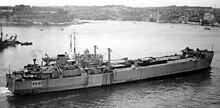Roll-on/roll-off
While smaller ferries that operate across rivers and other short distances often have built-in ramps, the term RORO is generally reserved for large seagoing vessels.On PCCs, cargo capacity is often measured in RT or RT43 units (based on a 1966 Toyota Corona, the first mass-produced car to be shipped in specialised car-carriers and used as the basis of RORO vessel size.[5] The seagoing RORO car ferry, with large external doors close to the waterline and open vehicle decks with few internal bulkheads, has a reputation for being a high-risk design, to the point where the acronym is sometimes derisively expanded to "roll on/roll over".The Edinburgh, Leith and Newhaven Railway was formed in 1842 and the company wished to extend the East Coast Main Line further north to Dundee and Aberdeen.As bridge technology was not yet capable enough to provide adequate support for the crossing over the Firth of Forth, which was roughly five miles across, a different solution had to be found, primarily for the transport of goods, where efficiency was key.The company hired the up-and-coming civil engineer Thomas Bouch who argued for a train ferry with a roll-on/roll-off mechanism to maximise the efficiency of the system.[10][9][page needed] Although others had had similar ideas, Bouch was the first to put them into effect, and did so with an attention to detail (such as design of the ferry slip) which led a subsequent President of the Institution of Civil Engineers[11] to settle any dispute over priority of invention with the observation that "there was little merit in a simple conception of this kind, compared with a work practically carried out in all its details, and brought to perfection.From 10 February 1918, high volumes of railway rolling stock, artillery and supplies for the Front were shipped to France from the "secret port" of Richborough, near Sandwich on the South Coast of England.It was much easier to move the large, heavy artillery and tanks that this kind of modern warfare required using train-ferries as opposed to repeated loading and unloading of cargo.The British evacuation from Dunkirk in 1940 demonstrated to the Admiralty that the Allies needed relatively large, seagoing ships capable of shore-to-shore delivery of tanks and other vehicles in amphibious assaults upon the continent of Europe.As an interim measure, three 4000 to 4800 GRT tankers, built to pass over the restrictive bars of Lake Maracaibo, Venezuela, were selected for conversion because of their shallow draft.To carry 13 Churchill infantry tanks, 27 vehicles and nearly 200 men (in addition to the crew) at a speed of 18 knots, it could not have the shallow draught that would have made for easy unloading.In three separate acts dated 6 February 1942, 26 May 1943, and 17 December 1943, Congress provided the authority for the construction of LSTs along with a host of other auxiliaries, destroyer escorts, and assorted landing craft.Colonel Frank Bustard formed the Atlantic Steam Navigation Company, with a view to cheap transatlantic travel; this never materialised, but during the war he observed trials on Brighton Sands of an LST in 1943 when its peacetime capabilities were obvious.On the morning of 11 September 1946 the first voyage of the Atlantic Steam Navigation Company took place when Empire Baltic sailed from Tilbury to Rotterdam with a full load of 64 vehicles for the Dutch Government.The original three LSTs were joined in 1948 by another vessel, LST 3041, renamed Empire Doric, after the ASN were able to convince commercial operators to support the new route between Preston and the Northern Ireland port of Larne.At this point ASN were made responsible for the management of twelve Admiralty LST(3)s brought out of reserve as a result of the Suez Crisis too late to see service.[21] In 1957, the US military issued a contract to the Sun Shipbuilding and Dry Dock Company in Chester, Pennsylvania, for the construction of a new type of motorized vehicle carrier.Atlantic Conveyor was sunk by Argentine Exocet missiles after offloading the Harriers to proper aircraft carriers, but the vehicles and helicopters still aboard were lost.











Roro (disambiguation)Rolling highwayRollout/Rollinarticulated haulersPort of Baltimoreinland waterwayscargo shipsmotorcyclestruckssemi-trailer truckstrailersrailroad carsself-propelled modular transporterlift-on/lift-offferry slipsriversferriescruiseferriesbargestonnagelanes in metresMS Color MagicColor LineFinlandAker FinnyardsUlyssesa novel byJames JoyceIrish FerriesDublinHolyheadMV Bali Seatrain ferryCoatzacoalcosMobileLarvikNorwayHirtshalsDenmarkPeninsula Searoad TransportBastø FosenHortenTønsbergFredrikstadAuto carrierVolkswagen AGK LineMafi roll trailersshort tonslong tonsLloyd's RegisterAuriga LeaderNippon YusenMV TønsbergCross Sound FerryMT Petar HektorovićList of RORO vessel accidentsbulkheadsMS Herald of Free Enterprisefree surface effectcapsizeTEV WahineMS EstoniafreeboardMV Cougar AceMV Modern ExpressFranceUSNS ShughartStrykercontainer shipcontainerizedG4 classbreak-bulk cargoLarge, Medium-Speed Roll-on/Roll-offMilitary Sealift CommandMonkland and Kirkintilloch RailwayForth and Clyde CanalScotlandLeviathanEdinburgh, Leith and Newhaven RailwayEast Coast Main LineDundeeAberdeenFirth of ForthThomas Bouchstationary steam enginesBouch'sadjustable rampferry slipInstitution of Civil EngineersBurntislandGrantonThomas Graingernot opened until 1890Tay Rail BridgeWorld War IRichboroughPort of SouthamptonBritish Railway companiesCanadianM4 ShermanAllied invasion of SicilyWorld War IIlanding shipsevacuation from DunkirkAdmiraltyamphibious assaultsLake MaracaiboVenezuelaHMS BoxerChurchillinfantry tanksUnited States NavyBureau of ShipsRoyal Navydestroyer escortslanding craftaircraft carrierNewport News, VirginiaSS Empire DoricRichborough PortFrank BustardAtlantic Steam Navigation CompanyBrighton Sandsbareboat charterEmpire Baltic